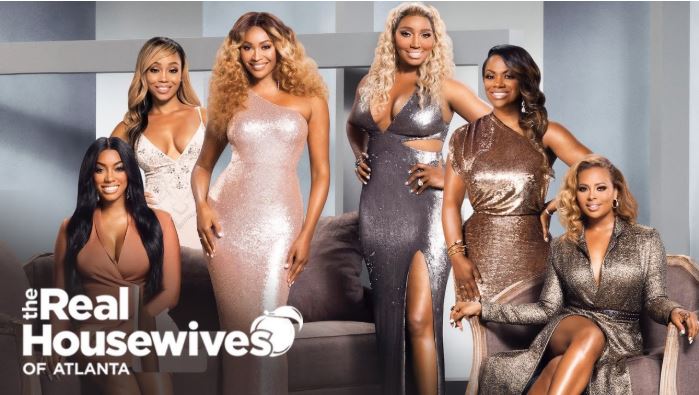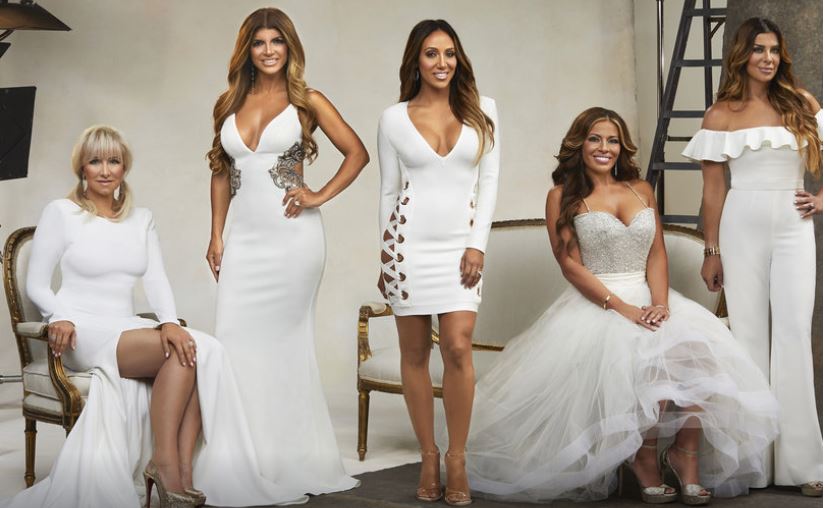
How the Real Housewives built cable’s biggest fan base
Six former Real Housewives are sitting onstage in a packed ballroom in Manhattan when an audience member, during a question and answer portion, politely asks if Caroline Manzo would be willing to throw a slice of ham at him. Like, at his face. Caroline, the redheaded ex-matriarch of the Real Housewives of New Jersey with infinite quotable insults (“you hang out with trash, you start to smell like garbage”) and possible mafia ties, of course, says yes. So the guy gets on stage, ham in hand, and Caroline flogs him with lunch meat.
The request is a reference to a scene from season two, way back in 2010, when Manzo’s three adult children are making sandwiches and suddenly start throwing ham at each other. It’s also indicative of a certain kind of rhetoric common in online fandoms, wherein the fan expresses their adoration by asking the celebrity to run them over or fling them from a building. That to be in the presence of the object of their admiration is worth being humiliated, or murdered.
We are at the first-ever BravoCon, a three-day event where 10,000 people have paid between $125 for a one-day general admission pass and $1,500 for a three-day super VIP package to get close to to their favorite stars. Attendees, most of them women in their 20s, 30s, and 40s, look not unlike “Bravolebrities” themselves: They have perfect TV blowouts and wear leopard print and are drinking wine before noon; in an alternate timeline they could have been the ones onstage throwing ham at people. They are here alongside the stars of reality shows like Southern Charm, Million Dollar Listing, Below Deck, and the network’s crown jewel, the Real Housewives franchise, for panel discussions and photo ops devoted to the celebration of what can only be described as the Bravo Extended Universe.
That universe, which began in 2006 with the Real Housewives of Orange County, is wide-reaching, ever-growing, and comfortingly cohesive — at BravoCon, executive producer Andy Cohen announced the addition of the Real Housewives of Salt Lake City, where fans will watch the same slice of wealthy socialites they’ve come to expect — except this time, with Mormons. Spinoffs are frequent: The biggest stars sometimes get miniseries in the lead-up to a big life event, like a wedding; one former Atlanta housewife has carried her own show since 2012; and one of the network’s most successful shows, Vanderpump Rules, began as a spinoff of the Real Housewives of Beverly Hills. Every weeknight, stars from the Bravo universe congregate on Cohen’s talk show, Watch What Happens Live, to gossip and share news from their corners of the galaxy.
Over the past decade and change, this web of television shows has amassed a cultish, millions-strong following of superfans who pour over the details of reality stars’ lives and now, have traveled to New York City to pose for pictures with them. Though I am here as a journalist, I also count myself among them: people who have spent countless hours watching the network’s shows, following Bravo gossip Instagram accounts, listening to more than one Bravo podcast, and breathlessly discussing news in Housewives Facebook groups and Slack rooms. That BravoCon — an intricately orchestrated production that involved three locations, a pop-up museum, a 2,000-audience-member episode of Watch What Happens Live, and the handling of dozens of professionally high-maintenance celebrities — can even exist and succeed is a testament to fans’ unwavering loyalty to watching other people’s lives.
“Housewives fans are like sports fans,” remarked Kyle Richards, a Beverly Hills housewife, during the WWHL taping. That’s not actually true, though — they’re way more into it.
How Bravo built an empire out of a single reality show
Bravo used to be fancy. At its founding in 1980, there were no commercials, and programming included classic films, ballets, and operas. Then in 2002, NBC bought Bravo and shortly thereafter pivoted to the then-buzzy genre of reality television, beginning with Queer Eye for the Straight Guy and eventually Project Runway, Top Chef, and the Real Housewives of Orange County.

The latter was meant to act more like an anthropological nature documentary than the wine-slinging, wig-pulling reputation it earned in later years. Riding off the success of ABC’s Desperate Housewives and Fox’s The O.C., the show fixated on five women living in a gated community in Coto de Caza, and only occasionally showed them interacting with each other, much less actually fighting.
“I thought I was just helping out a friend,” says Jeana Keough, one of the original cast members when I meet her in the BravoCon press room. “[Executive producer] Scott Dunlap was my neighbor, and for years he’d say, ‘I want to do a Curb Your Enthusiasm show about your family.’”
She gives partial credit to the 2007 Writers’ Guild of America strike for the early success of the show — it was one of the few that didn’t have much use for writers, after all. But it’s what Bravo ended up doing with that success — replicating the formula seamlessly into nine more cities and endless spinoffs — that created a single, shiny universe where all the Bravo stars seemed to reside, launching businesses and shilling products so that even viewers could buy their way into it.
BravoCon attendees I spoke to recalled getting hooked on a single show — The Real Housewives of Beverly Hills or Million Dollar Listing, before eventually watching enough Bravo shows that they’re now fully invested in whether one employee of an ex-Housewife Photoshopped text messages to claim that she slept with a different former employee. Bravo has become a cultural behemoth, one that has been discussed and debated for more than 10 years — whether it is good or bad, real or fake, trash TV or high camp.
Yes, the stereotype of the Real Housewives being about a bunch of wealthy middle-aged women screaming at each other has some basis in truth. While the early episodes of Orange County were relatively light on interpersonal drama, by the time New York and Atlanta debuted in 2008, the Housewives formula had been tweaked to ensure rivalries would ensue. There have been physical fights. At times the women say unfathomably cruel things to each other. There have also been extraordinarily dark moments — women relapsing on their sobriety, women being domestically abused, women finding out while on camera that their mother has died; women dealing with addiction and infidelity and divorce and depression.
Yes, the stereotype of the Real Housewives being about a bunch of wealthy middle-aged women screaming at each other has some basis in truth. While the early episodes of Orange County were relatively light on interpersonal drama, by the time New York and Atlanta debuted in 2008, the Housewives formula had been tweaked to ensure rivalries would ensue. There have been physical fights. At times the women say unfathomably cruel things to each other. There have also been extraordinarily dark moments — women relapsing on their sobriety, women being domestically abused, women finding out while on camera that their mother has died; women dealing with addiction and infidelity and divorce and depression.
These issues are also what give the Real Housewives themselves a degree of relatability despite their fabulous wealth. “Relatable” was a refrain I heard multiple times at BravoCon from both fans and stars, as reasons for the show’s massive success, which I found somewhat paradoxical. For as foreign as starting a cancer charity after you’ve been accused of helping someone fake cancer or spending $60,000 on a 4-year-old’s birthday party is to most people, everyone can understand the experience of feeling excluded or bullied. Drama ranges from serious marital issues and impending financial doom to pure petty gossip; on any episode of a Bravo show there’s something for everyone to theoretically “relate” to, even if the trappings of the stars’ lives include indoor pools and living room-sized closets. However dark a show gets, there’s at least usually a nice kitchen to look at.
“Relatability” gets more complicated, however, when considering the Housewives franchise’s track record with race. Shows have historically been divided, with Atlanta and Potomac primarily centered on black women and the others largely white; a few months ago, the announcement that Beverly Hills will soon feature its first black cast member was major news. Though Bravo shows include a breadth of racial and sexual diversity, Housewives has always been mostly segregated. Who gets to relate to which Housewife, then, becomes more complicated.
Even so, Housewives fans themselves are diverse — the tenor of the conversation these days celebrates how so many of its fans are feminists, women, gay men, and queer people who digest the shows with both earnestness and irony, and who understand that the Real Housewives is best viewed as fun escapism rather than something prescriptive or aspirational.
Why we keep watching Bravo — and why Bravolebrities keep opting in
We’re in line to take photos with a handful of men from the Bravo universe — Craig of Southern Charm, a show about old-money millennials in Charleston; and the Toms (Sandoval and Schwartz) of Vanderpump Rules — when I meet three women who’ve traveled to BravoCon from Washington, DC, and Seattle. They have “kind of important jobs,” they laugh; one is a lawyer, another works in climate communications, and the third is a planned gift fundraiser. “It’s really nice to come home and unwind and enjoy the irreverence and silliness and drama,” says one of them, Amy.
Mary, the lawyer, says, “I also, well, I always just want to yell at people all day at work and I can’t. So it’s nice to see these people just openly yelling at each other, which I know isn’t a great reason, but I also really dig it. Even in their theoretical worst moments, they are freaking hilarious.”







